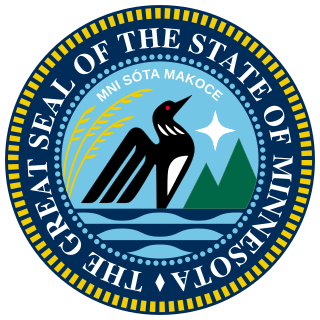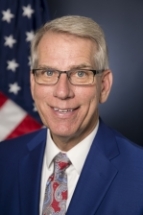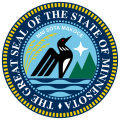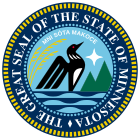
The Minnesota Senate is the upper house of the Legislature of the U.S. state of Minnesota. At 67 members, half as many as the Minnesota House of Representatives, it is the largest upper house of any U.S. state legislature. Floor sessions are held in the west wing of the State Capitol in Saint Paul. Committee hearings, as well as offices for senators and staff, are located north of the State Capitol in the Minnesota Senate Building. Each member of the Minnesota Senate represents approximately 80,000 constituents.

The California State Senate is the upper house of the California State Legislature, the lower house being the California State Assembly. The state senate convenes, along with the state assembly, at the California State Capitol in Sacramento.

The lieutenant governor of Minnesota is a constitutional officer in the executive branch of the U.S. state of Minnesota. Fifty individuals have held the office of lieutenant governor since statehood. The incumbent is Peggy Flanagan, a DFLer and the first Native American elected to a statewide executive office in Minnesota's history.

The lieutenant governor of Texas is the second-highest executive office in the government of Texas, a state in the U.S. It is the second most powerful post in Texas government because its occupant controls the work of the Texas Senate and controls the budgeting process as a leader of the Legislative Budget Board.

The Senate of Virginia is the upper house of the Virginia General Assembly. The Senate is composed of 40 senators representing an equal number of single-member constituent districts. The Senate is presided over by the lieutenant governor of Virginia. Prior to the American War of Independence, the upper house of the General Assembly was represented by the Virginia Governor's Council, consisting of up to 12 executive counselors appointed by the colonial royal governor as advisers and jurists.

The majority leader of the New York State Senate is elected by the majority of the members of the New York State Senate. The position usually coincides with the title of temporary president of the State Senate, who presides over the session of the State Senate if the lieutenant governor of New York is absent. The temporary president of the State Senate becomes acting lieutenant governor for the remainder of the unexpired term in case of a vacancy in the office of lieutenant governor, or until a new lieutenant governor is appointed In case of a vacancy in the offices of both the governor and lieutenant governor at the same time, the temporary president of the State Senate becomes Acting Governor. If the double vacancy occurs until three months before the mid-term state elections, a special election for governor of New York and lieutenant governor is held. If the double vacancy occurs later, the Temporary President of the State Senate acts as governor until the end of the unexpired term. The temporary president of the State Senate retains both majority leadership and a seat in the State Senate while acting as lieutenant governor or governor.

The lieutenant governor of Nebraska is the highest-ranking executive official in the State of Nebraska after the governor. According to the Nebraska State Constitution, in the event a governor dies, becomes permanently incapacitated, resigns, or is removed from office, the lieutenant governor will become governor.

The Oklahoma Senate is the upper house of the two houses of the Legislature of Oklahoma, the other being the Oklahoma House of Representatives. The total number of senators is set at 48 by the Oklahoma Constitution.

The president pro tempore of the Oklahoma Senate is the second-highest-ranking official of the Oklahoma Senate and the highest-ranking state senator. The Oklahoma Constitution designates the Lieutenant Governor of Oklahoma as the highest-ranking official, serving ex officio as President of the Senate, even though the lieutenant governor only votes in the case of a tie. During the lieutenant governor's absence, the president pro tempore presides over sessions. By longstanding custom, the lieutenant governor presides over sessions devoted to ceremonial purposes, while the bulk of the legislative management and political power is reserved for the president pro tempore, who is elected directly by the Oklahoma Senate.

The Louisiana State Senate is the upper house of the state legislature of Louisiana. All senators serve four-year terms and are assigned to multiple committees.

Minnesota is known for a politically active citizenry, with populism being a longstanding force among the state's political parties. Minnesota has consistently high voter turnout; in the 2008 U.S. presidential election, 77.8% of eligible Minnesotans voted – the highest percentage of any U.S. state or territory – versus the national average of 61.7%. This was due in part to its same day voter registration laws; previously unregistered voters can register on election day, at their polls, with evidence of residency.

The lieutenant governor of Indiana is a constitutional office in the US state of Indiana. Republican Suzanne Crouch, who assumed office January 9, 2017, is the incumbent. The office holder's constitutional roles are to serve as the president of the Indiana Senate, become acting governor during the incapacity of the governor, and become governor should the incumbent governor resign, die in office, or be impeached and removed from office. Lieutenant governors have succeeded ten governors following their deaths or resignations. The lieutenant governor holds statutory positions, serving as the head of the state agricultural and rural affairs bureaus, and as the chairman of several state committees.
The following table indicates the party of elected officials in the U.S. state of Arkansas:
The following table indicates the party of elected officials in the U.S. state of Minnesota:
The following tables indicate the historic party affiliation of elected officials in the U.S. state of Wisconsin, including: Governor, Lieutenant Governor, Secretary of State, Attorney General, State Treasurer, Superintendent of Public Instruction. The tables also indicate the historical party composition in the State Senate, State Assembly, the State delegation to the United States Senate, and the State delegation to the United States House of Representatives. For years in which a United States presidential election was held, the tables indicate which party's nominees received the state's electoral votes.

Michelle Louise Helene Fischbach is an American attorney and politician who is the U.S. representative from Minnesota's 7th congressional district. The district, which is very rural, is Minnesota's largest congressional district and includes most of the western area of the state. A Republican, Fischbach served as the 49th lieutenant governor of Minnesota from 2018 until 2019. As of 2024, she is the most recent Republican to have held statewide office in Minnesota.

The 1st Minnesota Legislature first convened on December 2, 1857. The 37 members of the Minnesota Senate and the 80 members of the Minnesota House of Representatives were elected during the General Election of October 13, 1857. Although the Constitution of the State of Minnesota, which had been adopted by the voters at the 1857 general election, was not ratified by the United States Senate until May 11, 1858, this was the first legislature of the State of Minnesota to convene in conformity with the state constitution.

A special election was held in the U.S. state of Minnesota on November 6, 2018, to elect a new senator for District 13 in the Minnesota Senate, caused by the resignation of Republican Senator Michelle Fischbach effective on May 25, 2018. The special election determined which political party would control the Senate given that Fischbach's resignation left it equally divided between the Republicans and the DFL. Jeff Howe won the special election, preserving a Republican one-seat majority. The special election coincided with the 2018 general election.

The Fifty-seventh Oklahoma Legislature was a meeting of the legislative branch of the government of Oklahoma, composed of the Senate and the House of Representatives. It met in Oklahoma City, Oklahoma from January 3, 2019, to January 3, 2021, during the first two years of the first administration of Governor Kevin Stitt. The November 2018 elections maintained Republican control of both the House and Senate.
















